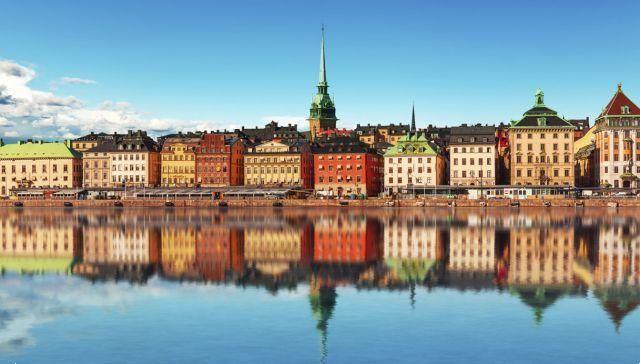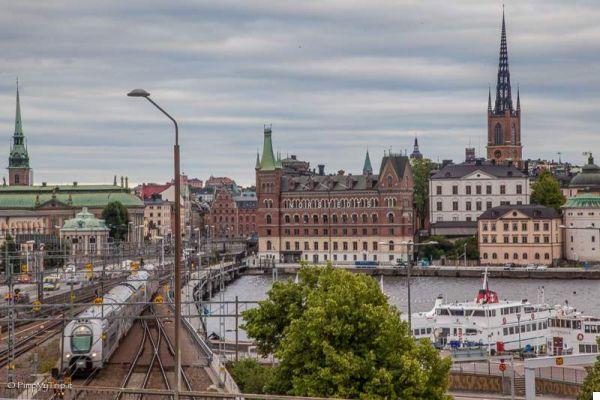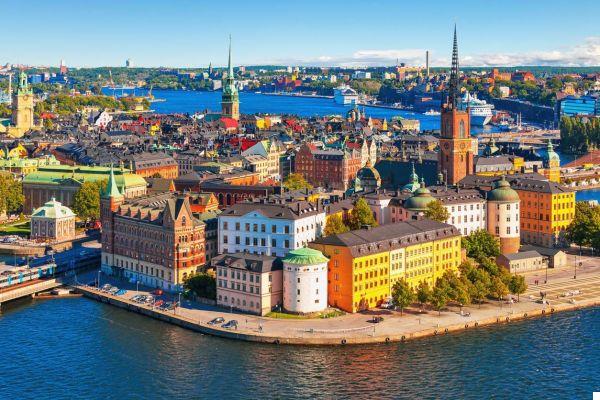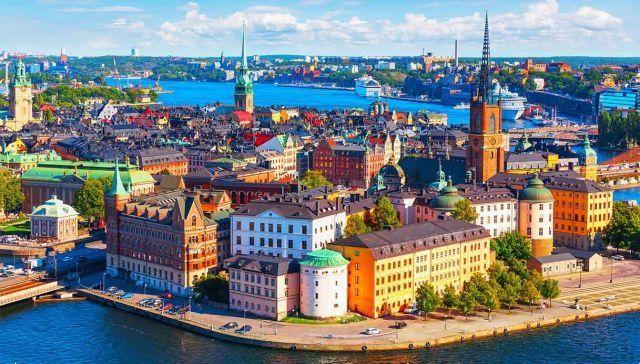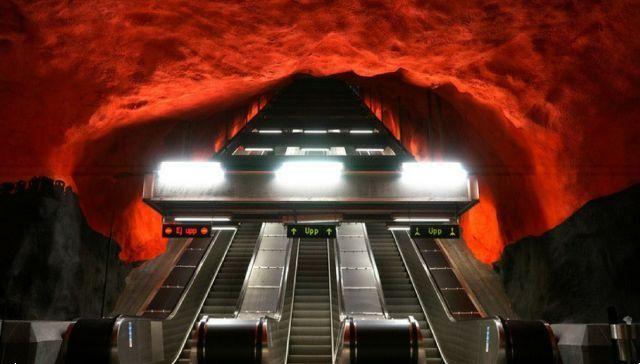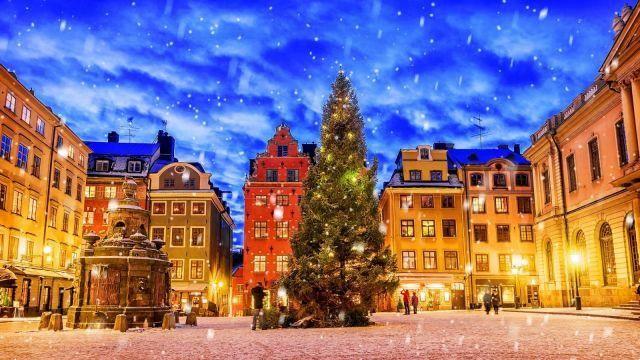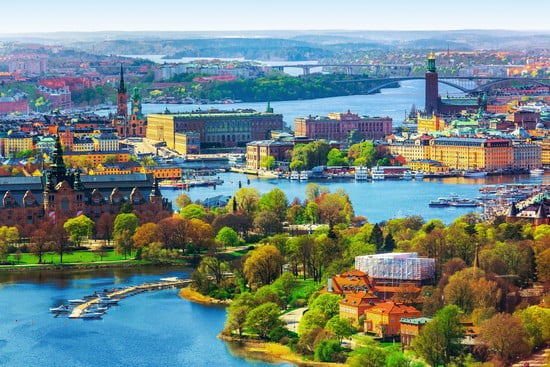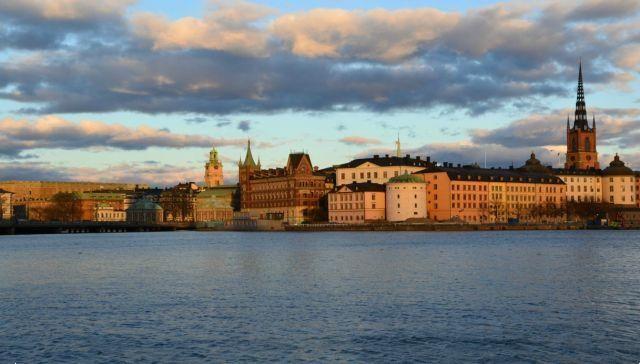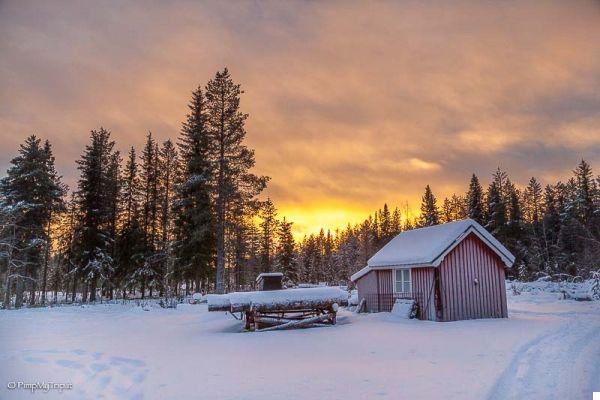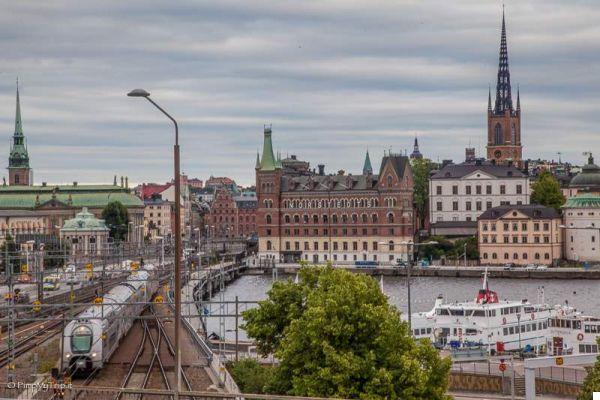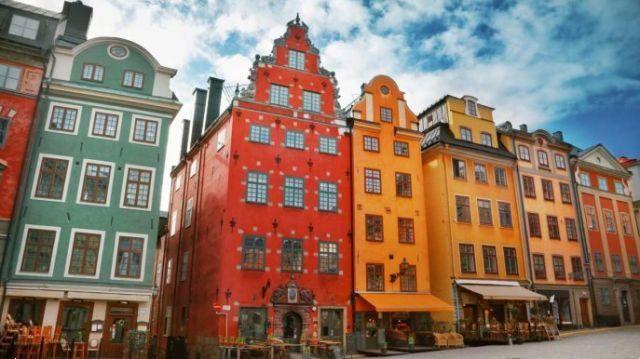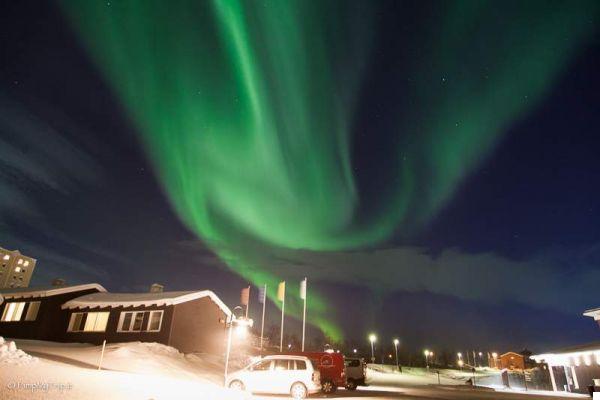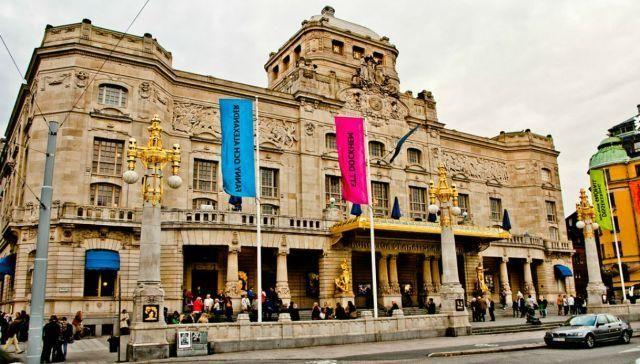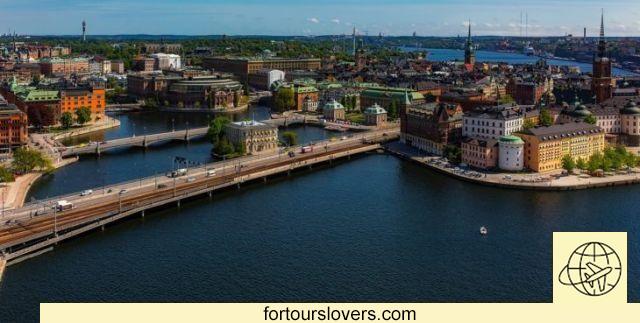
Stockholm
12 things to do and see in Stockholm and 2 not to doFourteen islands, fifty-seven ponti, seven natural reserves, a park national, over seventy percent of the energy coming from clean sources, nine out of ten inhabitants who live less than 300 meters from a public garden. And again: the most important port of the Baltic Sea, the financial heart of northern Europe, the city with the higher wages of the whole nation etc. A few numbers to get familiar with the Swedish capital, one ecological, efficient city and proud of hers multiculturalism. In short, a welcoming city, at the top of all the special rankings that measure well-being and quality of life on a global scale. For a list of hotels recommended by Booking.com click here. Here are the main attractions to see in the city. Happy reading.
1 Gamla Stan
The visit to Stockholm inevitably begins with his Old Town. To be precise, from Big Square Gamla Stan square, medieval city heart on theStadsholmen island. This is where the Royal Palace Cathedral (Storkyrkan) and Stock Exchange Palace (Börshuset) which, in addition to representing the Swedish financial center, hosts the Nobel Museum (Nobelmuseet) famous for his audio-archives with the speeches given on the occasion of the collection of the prize. It's not over, because they flow not far from the square Västerlånggatan e Österlånggatan two of the main streets of the Shopping city, daily invaded by thousands of tourists strolling among luxury boutiques and vintage shops. Do not miss.
2 Royal Palace
Royal residence e historical-cultural monument: the tourist appeal of the Royal Palace in Stockholm lies in this ambivalence. The castle already existed, but what we admire is the work ofarchitect Nicodemus Tessin the Younger appointed by King Charles XI (1655 - 1697) to adapt "Tre Kronor", the old medieval fortress, to the imperial aspirations of the royal house. Due to a series of vicissitudes, the project of Nicodemus Tessin saw the light only 60 years after the appointment. To be precise, in 1754, when the king Adolfo Federico and Queen Lovisa Ulrika were able to move permanently to the new building completed byarchitect Carl Harleman (under the artistic direction of Carlo Gustavo, son of Nicodemus Tessin). A triumph of baroque and roccocò where today the main ceremonies and state visits take place. Nonetheless - as mentioned at the outset - the Royal Palace in Stockholm is open to the public. To find out more about this tourist attraction visit the Official site: www.kungahuset.se. Don't miss the changing of the guard which takes place every day in summer (from Monday to Saturday, 12.15; Sunday 13.15) while in the other seasons it is repeated only three times a week (Wednesday and Saturday, 12.15; Sunday 13.15).
3 The Cathedral
Anyone interested in delving into the "Genius loci" Stockholm cannot fail to visit the Cathedral dedicated to St. Nicholas. A church a 5 naves which presents itself with that singular mix of gothic and baroque (especially Baroque, having been almost entirely rebuilt in the 700s) which from an architectural point of view links it to the nearby Royal Palace. Not surprisingly, until 1873, in the "Great Church" (the other name by which the building is called) took place the coronation of the Swedish royal family. Later, the celebrations were moved to the Royal Palace, leaving the Storkyrkan only two historical records: that of being the oldest church in the city (the origins date back to the 500th century), and above all of having been the place from which, in the XNUMXth century, the conversion to Lutheran doctrine. Here the preacher Olaus Petri (1493 -1552) gave his most famous speeches, the decisive ideological basis for the official conversion of the country to Protestantism in 1531. In addition to statue reminiscent of Olaus Petri outside the church, there are many other things to see. En passant we point out the bell tower, 66 meters high, i medieval paintings that decorate the ceiling in the Chapel of the Madonna, thesilver altar of the '600 and the wooden sculpture depicting St. George and the dragon made by the artist Bernt Notke, a native of Lübeck. For more information visit the Official site: www.svenskakyrkan.se.
4 Djurgården
One of the reasons why Stockholm boasts a very high quality of life is the presence of a huge naturalistic oasis in the center. We are talking aboutEcoPark on the island of Djurgården where, during the summer period, the inhabitants of the capital love to spend most of their free time practicing outdoor sports, or simply relaxing on the lawn. In autumn, however, before winter dictates its rhythms, Stockholm National Park is one of the favorite places for lovers of "Foliage" (the change in the color of the leaves from yellow to red) in recent years has become a real one photographic trend complete with articles, sites and applications dedicated to the phenomenon. It's not over, because some of the gods are based in Djurgården museums most important in Stockholm. Two in particular: Vasa Museum (Vasamuseet) e Skansen, open-air museum and city zoo. Below we see better what it is.
5 Vasa Museum
About 300 craftsmen at work from sunrise to sunset for 6 days the week. These are the impressive numbers for the construction of the vessel "Vasa" commissioned in 1625 from King Gustav II Adolfo (1594 -1632). Equally impressive is the size of the boat which, in the intentions of the king, should have resisted cannon fire and headwinds: 53 meters high, 68 in length, 6 sails, 64 cannons and about 150 sailors to steer it. Not only that, all around the vessel there were more than 1000 sculptures finely decorated, to symbolize the will to power of a nation which, despite the ten-year commitment on several war fronts (Russia, Poland and Germany), had managed, thanks to the audacity of its young sovereign, to increase its dominions. In this spirit, three years after the start of the works, the vessel was launched. The August 10th, 1628, in the presence of thousands of Stockholmers, the Vasa was ready to leave the port. But something went wrong and two strong gusts of wind were enough to compromise the static of the ship, which soon began to take on water from the open hatches of the guns. It was a catastrophe. Between 30 and 50 people lost their lives and the majestic warship strongly desired by Gustavo II Adolfo sank miserably. Three centuries later, in 1961, Sweden managed to pull up the wreck and make it, after long years of study and restoration, one of the main attractions of the country. In fact, there are tens of thousands of tourists who visit the Vasa Museum (Vasamuseet) on the island of Djurgården. For more information visit the place: www.vasamuseet.se (English version also available).
6 Skansen Museum
According to the Swedes, the Skansen is the best "Open air museum" in the world. Of course, patriotic pride counts, but the ingenuity and care with which its inventor, tal Arthur Hazelius (1833 - 1901), provided for the realization of this open-air museum is truly incredible. First of all for the intuition that is at the base of the work: we are in 1891 and Sweden, like other European nations, is in full transition towards the industrial economy. Far from opposing the development of his own country, Hazelius set himself the goal of preserving all local traditions that risked disappearing under the blows of modernity. To do this he personally bought over 150 rural homes from all over Sweden providing, as if that were not enough, also the furniture and the supply of the necessary household utensils. In short, man's purpose was, from the beginning, to create one miniature city representative of the customs and traditions of the entire Swedish people. Task fully accomplished, considering that the Skansen is one of the main attractions of Stockholm. In addition to its historical charm, the museum is also famous for its zoo in which they are present moose, reindeer, wolves, seals and other species typical of northern Europe. The eighteenth century is very characteristic wooden church of Seglora. Lit only by candles and furnished in an essential way, the inhabitants of Stockholm are very fond of it, to the point of having made it one of the most requested locations for weddings and baptisms. For more information visit the official website of the museum: www.skansen.se (English version available).
7 Junibacken
Controlled parks, green areas where you can play safely, dedicated menus in almost all restaurants, and a thousand other discounts, especially on public transport: Stockholm is a child-friendly city. Over the past 20 years, the Swedish capital has registered a "Baby boom" also due to the significant increase in immigration. The local authorities therefore decided to increase efforts to support families without neglecting, obviously, the tourist aspect of the matter. In fact, the presence of services and entertainment for children encourages the family tourism, making it very easy for parents to organize their vacation. Junibacken, on the island of Djurgården, is the emblem of this enlightened policy. Opened in 1996, Junibacken is a theme park in which environments and characters from Sweden's most popular fairy tales have been reconstructed, and beyond. For example, there is the home of Pippi Långstrump, or Pippi Longstocking as it is known in Spain, but there are also characters and situations that can be traced back to other Scandinavian fables. Junibacken's only drawback is crowding on weekends. For more information, visit the Official site: www.junibacken.se (English version available).
8 Grona Lund
Sull 'Djurgården island there is also the Grona Lund, Stockholm's largest amusement park, suitable for adults and children. Give her roller coaster, To rocking horses, passing through the terrifying house of spirits and the thousand other devilry of this kind of environment, Grona Lund is the right place if you want to spend a day full of joy and carefree. The organization, needless to say, is perfect: for children, for example, there is the identification bracelet in case they get lost. This certainly does not exempt parents from following their children; for sure, however, there is the awareness of being in a safe and controlled place. In short, Stockholm is one ideal city for families with children. Only a minimum of organization is needed, and above all do it in time. For more information You can consult the PDF in Spanish with all the main info downloadable from the park's official website.
9 SkyView Ericsson Globe
After a visit to the museums of Djurgården, a visit to theEricsson Globe, futuristic building in concrete and steel where for years the most important sports events in Sweden have been held. Since 2010, two have been mounted on the external facade of the building spherical glass bubbles that lead visitors to the top of the structure, from which you can enjoy a beautiful panorama of the city. In short, Stockholm is proof that the cult of tradition (represented by Skansen), can easily coexist with the technological modernity (of which the SkyView is the emblem). Indeed, from the tourist point of view, the care of the two aspects is a source of employment and profit for the inhabitants of the city. For more information for the times, opening and closing days and prices of the attraction click here.
10 Moderna Museet
Il Museum of Modern Art Stockholm is not only one of the most important in Europe (over 130.000 works by contemporary and great artists of the past) but it is also innovative as an approach, especially forattention dedicated to children which are reserved for numerous spaces and activities within the structure. The building is located on theSkeppsholmen island and was built in 1998 bySpanish architect Rafael Moneo concurrently with the designation of the city a European Capital of Culture. We were saying, contemporary artists of the most diverse fields (sculpture, painting, photography, mass media installations) and giants of the past including Matisse, Kandinsky, von Dardel, Up to Edvard Munch, author of the famous "The Scream" kept in the National Gallery of Oslo. In addition to the works present, temporary exhibitions and activities for children, the Moderna Museet in Stockholm also deserves landscape context in which it is inserted. Green and nature all around and a wonderful panorama Stockholm, especially in the evening. For more information visit the Official site: www.modernamuseet.se. Not to be missed!
11 Skogskyrkogården
At first glance it is strange to think of a cemetery as a tourist attraction. Instead, it is not only possible, but to read the reviews found on the net, for many Skogskyrkogården is one of Stockholm's main attractions. The "Cimitero del Bosco" is located at Enskede, a district on the southern side of the city and was designed in 1914 by Gunnar Asplund e Sigurd Lewerentz, two young architects who had won the international competition announced by the then municipal administration. The idea behind the competition was the preparation of a cemetery area that had the fusion of architecture and nature. Not the "usual" cemetery with all different tombs and chapels, which celebrate the singularity of the individual and / or family to which they belong, but a place that would instill the necessary serenity in the elaboration of mourning. A goal, that of the Stockholm administration, which the two architects fully achieved to the point that, 80 years after (1994) the opening of Skogskyrkogården, theUnesco has included the cemetery among the assets World Heritage Site. Finally two curiosities. The "Divina" is buried in Skogskyrkogården Greta Garbo (1905 -1990) whose body was moved from New York, where he died, and returned to his native city, 9 years after his disappearance. In addition the cemetery has a visitor center where to find information e map of the area. To learn more, visit the Official site: skogskyrkogarden.stockholm.se (English version available).
12 Blå Tåget
Among the many things to do in Stockholm the Blå Tåget, the "blue train" that connects the capital with Gothenburg, certainly deserves a mention. If you like to travel slow, sit comfortably in a vintage train which, however, combines vintage furniture with all the most modern comforts, then it is the experience that is right for you. Moreover, the landscape is truly fantastic, and therefore the Approximately 4 hours of walking between the two main Swedish cities, they fly away quickly with their eyes perpetually turned towards the window. The Blue Train, to put it in English, he leaves 2 times a day from Thursday to Monday, from both terminus. For more information on the cost and times of departure and arrival visit the Official site: www.blataget.com (English version available).
1 Do not violate the rules of civil coexistence
What we said about the things not to do in Munich applies to Stockholm: respect comes first. From not occupying the left on the escalators, to the supermarket line up to the road signs, the rules of civil coexistence are sacred. An egalitarian aspiration that in Sweden (but the discourse can also be extended to other Scandinavian nations) is inculcated from an early age, subordinating individual fulfillment (which is not demonized) to the needs of the community. From this teaching also derives the calmness of the way of conversing and, conversely, the disapproval of those who raise their tone too much and / or tend to monopolize the discussion. Obviously, the one described is a stereotype that, although operating, only photographs a part of Stockholm's everyday life. Anyhow, better to behave well and not derogate from the principles of good manners which the Swedes are very fond of.
2 What not to forget in your suitcase
La Stockholm's tourist season runs from mid-May to mid-September. Of course, nothing prevents you from visiting the Swedish capital even in winter (especially during the Christmas period), but it is during the 4 months indicated above that the city records the greatest flow of visitors. That said spring and summer are very different from what we are used to in southern Europe. The days are variable and temperatures are definitely cooler compared to our seasonal averages. So, they serve sweaters, windproof and rainproof jackets and comfortable shoes. And yes, because Stockholm is easy to get around by public transport, but also on foot. Indeed, during the summer, it is absolutely recommended let yourself go through the streets of the city. It is no coincidence that it is often compared to Venice (it is called the "Venice of the North" although the name is also used for other locations) and therefore, just as we have recommended for the lagoon city, it is worth walking around without necessarily having a fixed destination.




